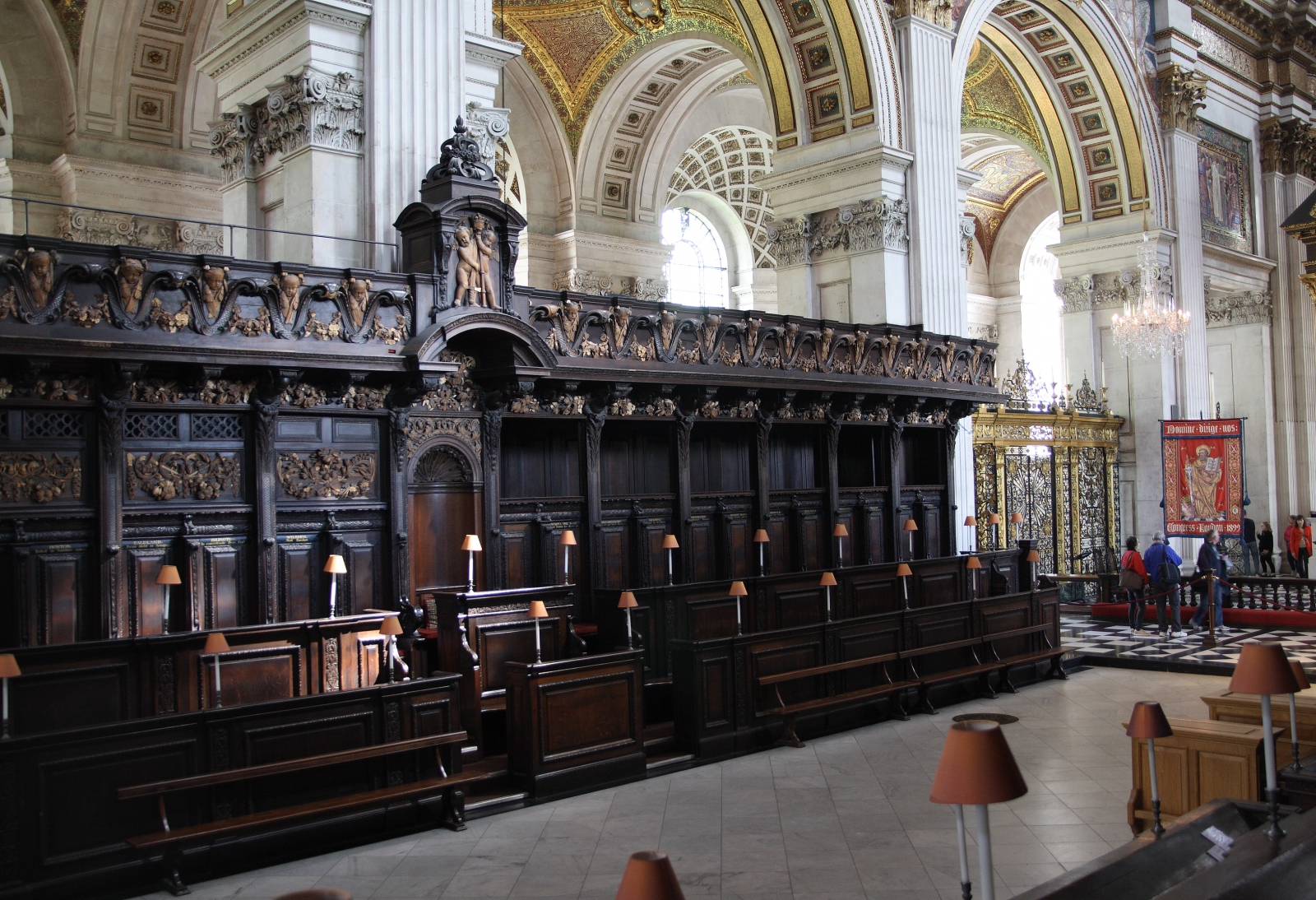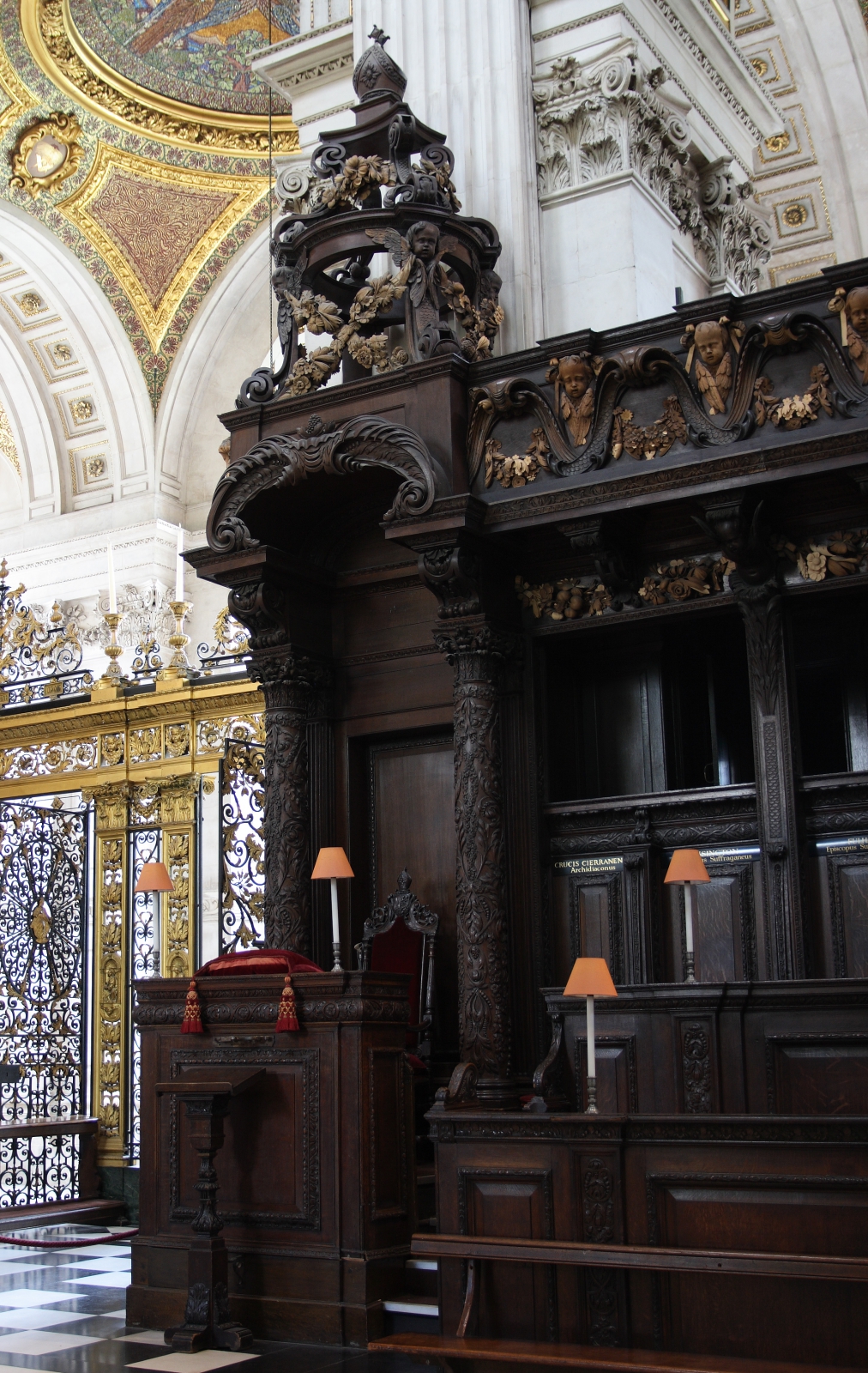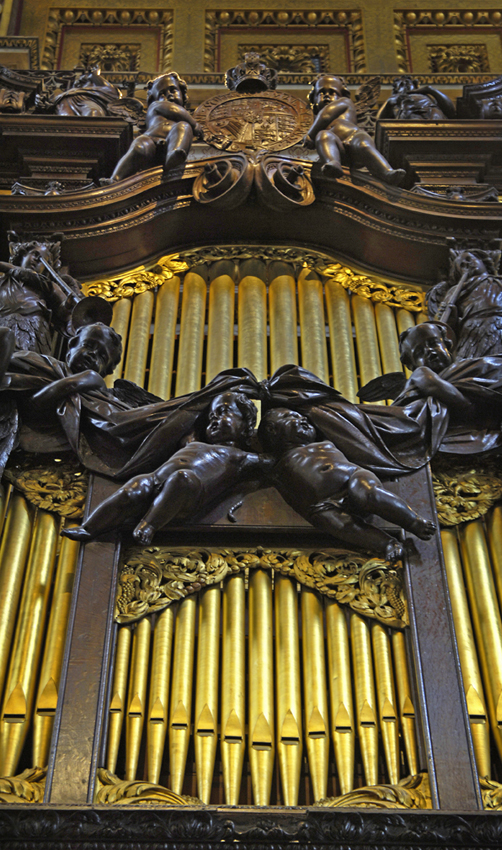Woodcarvers studying Gibbons will find St. Paul’s cathedral both delightful and disappointing. Those who can visit St. Paul’s to see the carvings in person will be delighted. These are spectacular carvings which need to be seen in person. That’s because there is almost no other way to see them.
Delightful
The delight is standing in one place, slowly turning completely around, and seeing the highest concentration of Gibbons carvings any place in the world.
Two rows of choir stalls, 24 stalls in each row, face each other. Above every stall is a limewood putto with folded wings. Between every putto are oak architectural arches and limewood floral swags. Stop counting here, and you’ll have about 200 objects. Drop down below the cornice and find yet more limewood floral swags. Lower still are 6 wide panels completely filled with limewood flowers and long trumpets. There are openings for 24 panels. Only 6 are filled now. Were all 24 openings once filled? I don’t know.
In the middle of each of the two rows of choir stalls there is a center “throne,” a wider seat featuring a carved niche shell above, a large decorative panel above that, a canopy topped by a tower rising above all. The throne in the middle of the north row of choir stalls is reserved for the Lord Mayor of London. The decorative panel above the Mayor’s throne is filled with flowers. The throne in the middle of the south row was originally for the bishop, but is now known as the dean’s throne. The decorative panel above the deans’s throne is also filled with flowers, and features two pelicans feeding their young.
Sometime after drawing plans for the choir stalls, Wren¹ added yet another Bishop’s Throne at the east end of the south row of choir stalls. That throne is also heavily decorated with dozens of carvings. We’re probably nearing a count of 400 carved objects.
¹ Sir Christopher Wren, the architect of St. Paul’s Cathedral and many other buildings destroyed by the Great Fire.
Turn away from the high altar, toward the open nave of the cathedral and note the organ cases at the end of the choir stalls. When originally constructed in the 1690s, a single very wide organ case sat atop a screen that spanned the space between the rows of choir stalls, like a bridge. I found an engraving that shows the original arrangement. The current arrangement was made in the 1870s, splitting the organ case and turning the resulting two cases 90 degrees. The choir stall rows and organ cases were pushed farther apart and the screen was removed. That change greatly opened up the view from the nave to the high altar. I lost count of how many angelic figures there are on the organ cases, how many floral swags and putti there are on the casework near its base, how many columns with vertical drops of flowers, and how many Acanthus clad brackets supporting the cases.
Beyond the limewood carvings, there are plentiful oak carvings, the arches between the putti, corbels (or are they consoles?) with yet more putti, columns, and what seems to be miles of mouldings around the wainscoting panels.
I have run out of adjectives to describe these carvings, their abundance, and their baroque beauty. I stood amazed, not wanting to leave, but also not wanting to overstay the welcome of our escort, Gabrielle Porter. Seeing hundreds of carvings, all in one space, in person, is truly a memorable experience. These are spectacular carvings which need to be seen in person. As of now, it’s the only way to really appreciate the carvings.
Two things stand out for me.
First: Other than the sculptural figures, these carvings are not as deep, or high relief as others, such as at St. James Piccadilly. Wren imposed a limit, specifying that decorative carvings should protrude no more than 2 inches from their background. Gibbons managed to pack a lot of perceived depth into that 2 inches.
Second: If you look carefully at each of the putti faces, you’ll find that they are all different. Each of the 66 heads is unique. It would have been so easy to carve each of them the same, simple copies of the typical cherub. But that would have been boring. I’ve heard two stories about the different faces. One suggests that Gibbons used his own children as models. He and his wife Elizabeth had 10 children. The other story was from our escort. She says that one of the local legends is that as Gibbons walked to work each day, he would pick out and memorize the face of a child seen along the way and use that as the model for that day’s carving. BTW, Esterly suggests these heads were carved for the price of 1 Pound each. (Esterly, p162)
As you look at the pictures below, you’ll see hundreds of small repairs that are lighter in color than the surrounding parts. It’s little wonder that after 300 years, and after being taken down and remounted in at least two renovations, a few bits need repair. Looking closely at these repairs, you can also see subtle style differences between what Gibbons produced and what the more recent carvers have produced.



Part of the organ case, this is the only photo available from St. Paul’s. Note that the organ cases sit high above the cathedral floor, as if on top of the choir stalls. You can get a better idea of how they are positioned in the video below.
A YouTube video offers views of the organ cases and choir stalls:
Disappointing
Disappointment comes when searching for photos in books or online which can substitute for an actual visit to St. Paul’s. Only a few photos appear in books, and they are far too small to discern details. Imagine a panorama of 20 choir stalls in a photo that’s 3 inches wide. There are incredibly few photos on the Internet, as well. That’s probably because photography is prohibited in the cathedral and people don’t have a lot of personal photos to post on the Internet. The administration at St. Paul’s offered only these three photos of Gibbons’ work.
Even when you visit, you might feel stymied. The choir area is closed to sightseers. So too is the platform near the communion rail, where one might get a fine view of the organ cases. The solution is to look for the “Friends of St. Paul’s” desk, just beyond the sightseers’ entrance, and ask to be admitted to the choir to get a better look at the carvings. They will have someone escort you.
Oh, by the way…
The American Chapel – The British built a Memorial to Americans lost in World War II. The memorial is a small chapel in the apse, behind the high altar. Select item #13 on the cathedral map. The highlight of the memorial is the “Roll of Honor” a leather bound book containing 28,000 names of Americans who died defending the British Isles. Every day a page is turned in that book.
Gibbons Stonework – My focus was on the woodcarvings, but there is plenty of other Gibbons work to see on the outside of St. Paul’s, stone carvings, not woodcarvings. Festoons or garlands of flowers decorate nearly every window along the nave. Angels with the royal arms decorate the north pediment. I was so focused on the woodcarvings that I took no photos of the stone carvings. However, the Internet has an abundance of photos of St. Paul’s exterior, and quite a few of the stone carvings.
Organ concerts – For those of you who really like pipe organs, this video shows you 25 minutes of details and demonstrations of St. Paul’s very large pipe organ.. Who knew in 1697 when Gibbons was carving decorations for the organ case that the organ would one day have USB ports!
For the architects – In the “Collections” section of materials at St. Paul’s Internet site is a very extensive collection of architectural drawings by Wren and others. These are high quality scans of the original drawings and are well titled and organized. For example, see this drawing of how the original organ case was intended to fit just beyond the arch for the choir (“quire” in British English) area. The top of the collection of Wren drawings starts here.
Thank You!
Thank you, Gabrielle Porter (a Friend of St. Paul’s), for opening the gate and escorting us to the choir.
Thank you, Karen Hart, for granting permission to use photos from St. Paul’s Chapter House.
Between 2000 & 2005 I often attended the weekdays Evensong service. I would always make certain to be at the front of the queue when they opened the doors, since they allowed some attendees to sit in the choir stalls. This allowed up close viewing of Gibbons carvings for 45 minutes while enjoying the singing of the excellent boys choir.
That’s a really good reason to show up early. I find it unfortunate that the choir is now closed.